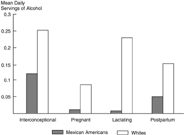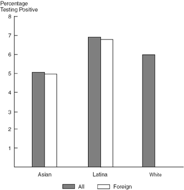Alcohol Use
Alcohol use during pregnancy has been associated with both shortand long-term negative health effects for infants, including congenital malformations and mental retardation.48 Women who consume large amounts of alcohol during pregnancy have higher rates of low-birth-weight babies than do nondrinkers.41 While the evidence is mixed, alcohol use during pregnancy appears to be low among Mexican-American and Southeast Asian women.
Using food frequency data from two Health and Nutrition Examination Surveys (the Hispanic HANES and the second HANES), Guendelman and Abrams compared mean daily servings of beer, wine, and liquor for 664 Mexican-American women and 1,156 White women across four stages of the reproductive cycle.46 On average, pregnant Mexican-American women consumed .02 daily servings of alcohol compared to .08 servings among pregnant White women. Interconceptional, pregnant, lactating, and postpartum Mexican Americans were far less likely than Whites to consume alcohol (Figure 9.3).
Vega et al., in their study of perinatal substance use among 30,000 women, assessed alcohol exposure at the time of delivery, employing

Figure 9.3. Mean daily servings of alcohol for Mexican-American and White women by reproductive stage. Source: Guendelman and Abrams (1994 [46]).
A study of Southeast Asian women participating in the San Diego Comprehensive Perinatal Program revealed low prevalence of alcohol consumption.49 Furthermore, urine toxicology screens of Asian women at delivery administered in the study by Vega et al. showed fewer positive screens for alcohol compared to Whites (5.1% vs. 6.1%). Anecdotal information suggests that alcohol intake may be restricted to the time of

Figure 9.4. Alcohol use of Asian, Latina, and White maternity patients. Source: Vega et al. (1993 [45]).
While important, it does not appear that alcohol has nearly as strong an impact on low birth-weight and infant mortality as cigarette smoking.10 However, the low prevalence rates of alcohol consumption during pregnancy in immigrant groups does suggest a reproductive health advantage.